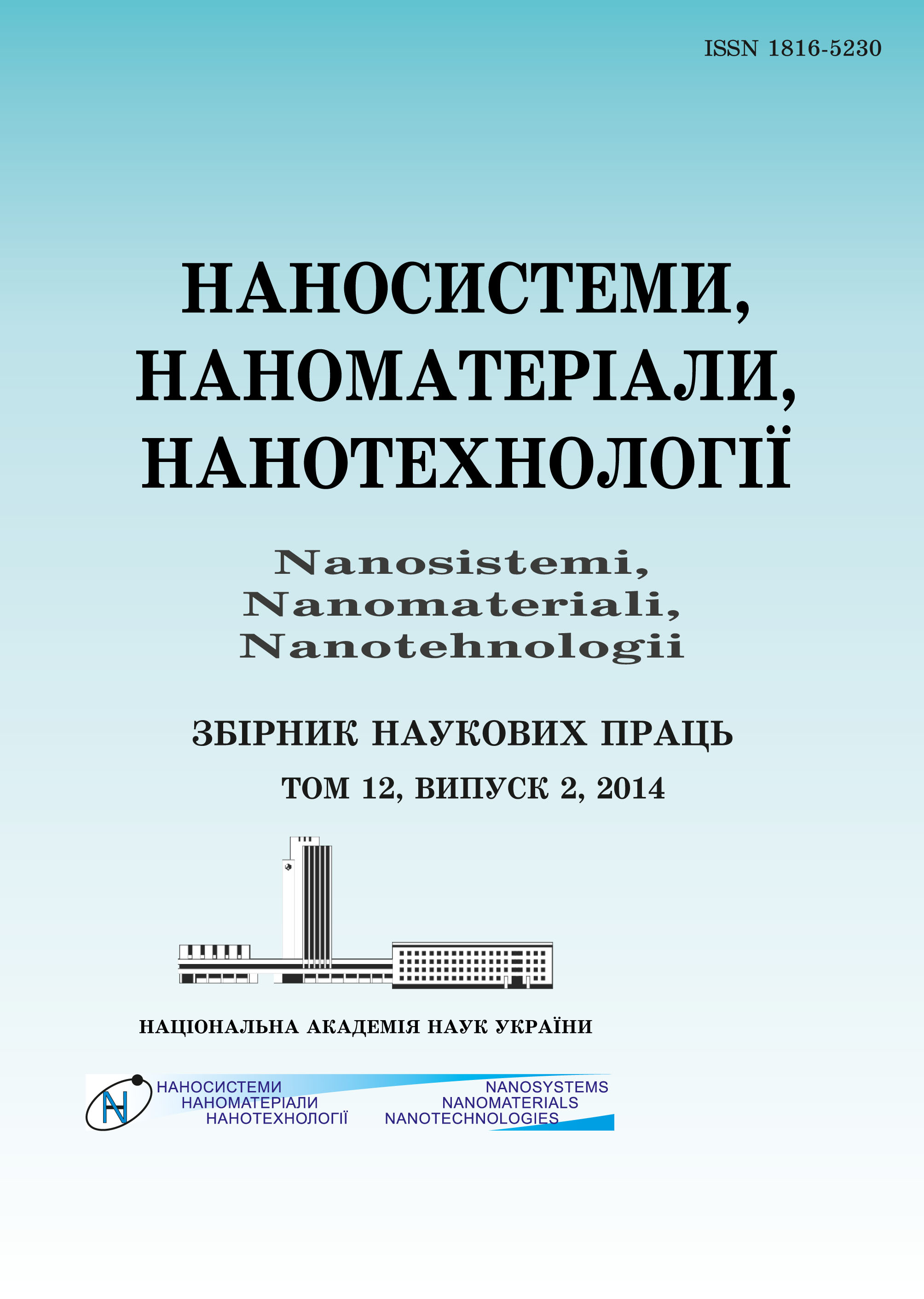|
|
|||||||||
 |
Year 2021 Volume 19, Issue 1 |
|
|||||||
|
|||||||||
Issues/2021/vol. 19 /Issue 1 |
A. K. M. Shahabuddin, Nasrin Jewena, Sujan Kumar Das, Jahirul Islam Khandaker, Farid Ahmed
«Low-Temperature Growth of ZnO Nanoparticles by Using Autoclave»
0177–0188 (2021)
PACS numbers: 61.05.cp, 61.46.Hk, 78.20.Ci, 78.30.Fs, 78.40.Fy, 78.67.Bf, 81.16.Be
Zinc-oxide nanoparticles have been synthesized by using an easy, cheap, and rapid green method, namely, hydrothermal method with the assistance of stainless-steel autoclave at two different temperatures (100\(^{\circ}\)C and 150\(^{\circ}\)C), and their structural, optical, and chemical properties are investigated. XRD analysis identified the hexagonal wurtzite-type structure of ZnO nanoparticles as well as indicated that the crystallite size increased from 10.08 nm to 37 nm along with the elevated growth temperature from 100\(^{\circ}\)C to 150\(^{\circ}\)C. The transmittance spectra showed a sharp decrease in the transmittance after crossing a certain wavelength that was the strong evidence of cut-off wavelength for the transmittance of ZnO nanoparticles. The observed band gaps from the Tauc plot were of 3.60 eV and 3.05 eV at growth temperature 100\(^{\circ}\)C and 150\(^{\circ}\)C, respectively. The FTIR spectrum showed the incomplete removal of organic solvent. However, more organic-solvent presence was observed at high growth temperature indicating existence of more impurity compared to lower growth temperature.
Keywords: ZnO nanoparticles, hydrothermal method, autoclave, optical properties, XRD, FTIR
https://doi.org/10.15407/nnn.19.01.177
References
1. A. H. Lu, E. L. Salabas, and F. Schuth, Angewandte Chemie InternationalEdition, 46, No. 8: 1222 (2007); doi:10.1002/anie.2006028662. Synthesis, Properties, and Applications of Oxide Nanomaterials (Eds.J. Rodriguez and M. Fernandes-Garcia) (Hoboken, NJ, USA: Wiley-Interscience: 2007).
3. J. H. Lee, D. N. Liu, and S. T. Wu, Introduction to Flat Panel Displays(Chichester, UK: John Wiley & Sons: 2008).
4. Metal Oxides: Chemistry and Applications (Ed. J. L. G. Fierro) (Boca Raton,FL: CRC Press: 2006).
5. C. Woll, Progress in Surface Science, 82, No. 2: 55 (2007);doi:10.1016/j.progsurf.2006.12.002
6. A. P. Alivisatos, D. J. Milliron, A. Meisel, E. C. Scher, and L. Manna, Na-ture Materials, 2, No. 6: 382 (2003); doi:10.1038/nmat902
7. K. Hummer, physica status solidi (b), 56, No. 1: 249 (1973);doi:10.1002/pssb.2220560124188A. K. M. SHAHABUDDIN, Nasrin JEWENA, Sujan Kumar DAS et al.
8. B. Monemar, Phys. Rev. B, 10, No. 2: 676 (1974); doi:10.1103/PhysRevB.10.676
9. C. M. Niemeyer, Angewandte Chemie International Edition, 40, No. 22: 4128(2001); doi:10.1002/1521-3773(20011119)40:22<4128::AID-ANIE4128>3.0.CO;2-S
10. D. J. Beebe, J. M. Bauer, R. H. Liu, J. S. Moore, C. Devadoss, B.-H. Jo,and Q. Yu, Nature, 404, No. 6778: 588 (2000); doi:10.1038/35007047
11. M. H. Huang, S. Mao, H. Feick, H. Yan, Y. Wu, H. Kind, E. Weber, R. Russo,and P. Yang, Science, 292, No. 5523: 1897 (2001); doi:10.1126/science.1060367
12. S. Fujita, S.-W. Kim, M. Ueda, and S. Fujita, Journal of Crystal Growth,272, No. 1: 138 (2004); https://doi.org/10.1016/j.jcrysgro.2004.08.078
13. P. X. Gao and Z. L. Wang, The Journal of Physical Chemistry B, 108, No.23: 7534 (2004); doi:10.1021/jp049657n
14. N. Singh, R. M. Mehra, A. Kapoor, and T. Soga, Journal of Renewable andSustainable Energy, 4, No. 1: 013110 (2012); doi:10.1063/1.3683531
15. R. Song, Y. Liu, and L. He, Solid State Sciences, 10, No. 11: 1563 (2008); https://doi.org/10.1016/j.solidstatesciences.2008.02.006
16. D. B. Bharti and A. V. Bharati, Luminescence, 32, No. 3: 317 (2017);doi:10.1002/bio.3180
17. N. Sharma, S. Kumar, and J. Kumar, Integrated Ferroelectrics, 186, No. 1:115 (2018); doi:10.1080/10584587.2017.1370333
18. D. Ramimoghadam, M. Z. Bin Hussein, and Y. H. Taufiq-Yap, ChemistryCentral Journal, 7, No. 1: 1 (2013); doi:10.1186/1752-153X-7-136
19. P. M. Aneesh, K. A. Vanaja, and M. K. Jayaraj, Synthesis of ZnO Nanoparticlesby Hydrothermal Method (Conference Proceedings), vol. 6639, p. 66390J.
20. K. Elen, H. Van den Rul, A. Hardy, M. K. Van Bael, J. D’Haen, R. Peeters,D. Franco, and J. Mullens, Nanotechnology, 20, No. 5: 055608 (2009);doi:10.1088/0957-4484/20/5/055608
21. A. B. Moghaddam, T. Nazari, J. Badraghi, and M. Kazemzad, InternationalJournal of Electrochemical Science, 4, No. 2: 247 (2009).
22. L. F. Koao, F. B. Dejene, R. E. Kroon, and H. C. Swart, Journal of Lumi-nescence, 147: 85 (2014); https://doi.org/10.1016/j.jlumin.2013.10.045
23. M. Sondergaard, E. D. Bojesen, M. Christensen, and B. B. Iversen, CrystalGrowth & Design, 11, No. 9: 4027 (2011); doi:10.1021/cg200596c
24. B. D. Cullity, Elements of X-Ray Diffraction (New York: Addison-WesleyPublisher: 1956).
25. C. S. Barrett and T. B. Massalski, Structure of Metals: CrystallographicMethods, Principles, and Data (New York: Pergamon: 1980).
26. S. Ilican, Y. Caglar, and M. Caglar, Journal of Optoelectronics and Ad-vanced Materials, 10, No. 10: 2578 (2008).
27. K. K. Nanda, F. E. Kruis, and H. Fissan, Phys. Rev. Lett., 89, No. 25:256103 (2002); doi:10.1103/PhysRevLett.89.256103
28. L. E. Greene, B. D. Yuhas, M. Law, D. Zitoun, and P. Yang, InorganicChemistry, 45, No. 19: 7535 (2006); doi:10.1021/ic0601900
29. E. A. Meulenkamp, The Journal of Physical Chemistry B, 102, No. 29: 5566(1998); doi:10.1021/jp980730h
30. H. I. K, J. M. C, D. J. K, and M. G. S, Journal of Ceramic Processing Research,3, No. 3: 146 (2002); http://www.jcpr.or.kr/journal/archive/view/101#
31. X. M. Sui, C. L. Shao, and Y. C. Liu, Applied Physics Letters, 87, No. 11:113115 (2005); doi:10.1063/1.2048808
 This article is licensed under the Creative Commons Attribution-NoDerivatives 4.0 International License ©2003—2021 NANOSISTEMI, NANOMATERIALI, NANOTEHNOLOGII G. V. Kurdyumov Institute for Metal Physics of the National Academy of Sciences of Ukraine. E-mail: tatar@imp.kiev.ua Phones and address of the editorial office About the collection User agreement |